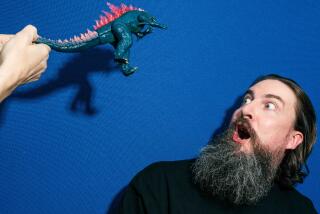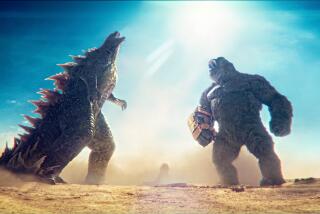MOVIE REVIEW : Beauty Meets Beast Again at Tribute to Wray : MOVIE REVIEW : Beauty Meets the Beast Again at Tribute to Wray and ‘Kong’
- Share via
One of the most indelible images in the history of the movies is the giant gorilla scaling the Empire State Building while clutching Fay Wray in his immense fist at the climax of “King Kong.” To see the 1933 film today is to realize how much fun the getting there really is--especially now that “King Kong” has been restored to its original grandeur by Turner Entertainment. It will screen today through Sunday at the Nuart as part of a tribute to Wray, whose autobiography, “On the Other Hand,” has just been published.
“King Kong” is the screen’s ultimate Beauty-and-the-Beast fable, and it endures through the power of an innocence that has all but vanished from the screen, and from our lives as well. The Kong-Wray relationship seethes with an implicit sexuality that seems free from calculation, a quality those who attempted a remake in the ‘70s could not hope to duplicate. There is no question that “King Kong” continues to disturb us on a level that resists articulation (but invites all manner of interpretation, including the comforting notion in the depths of the Depression that the forces of a modern technological society will eventually prevail). Offended by various Freudian-like analyses, Merian C. Cooper maintained to the end of his life that his film was “never intended to be anything but the best damn adventure picture ever made.”
The film was primarily the inspiration of Cooper, who wrote the original story with Edgar Wallace and who directed the film with Ernest B. Schoedsack. After an exposition-heavy opening, it proceeds with the pace and excitement of an old serial, with a cliffhanger finish to every sequence. Wray plays an unemployed New Yorker who faints into the arms of Robert Armstrong, a maker of jungle adventure films whose work has been criticized for its lack of “love interest.” (Armstrong’s breezy character seems an amalgam of Lowell Thomas and Frank “Bring ‘Em Back Alive” Buck.) In a flash, Wray is off to the East Indies with Armstrong and Bruce Cabot, a first mate who insists that a ship is no place for a woman but who, of course, swiftly falls for Wray.
Producer David O. Selznick’s grand manner emerges in the expedition’s discovery of an uncharted, mysteriously walled-off island and in the appearance of Kong and various dinosaurs, the justly celebrated creations of Willis O’Brien, whose work may seem primitive in the age of Spielberg but whose effects seem perfectly attuned to the elementary nature of the film.
When “King Kong” was rereleased in 1938, the Production Code Administration, which established severe new restrictions in 1934, demanded a number of cuts. By the late ‘50s, they had been restored to the film but they were grainy blowups of 16-millimeter footage. These inserts have now been replaced by 35-millimeter footage provided to Turner Entertainment by a film collector in exchange for a print of a 300-foot color sequence in the 1925 “Phantom of the Opera.” As might be expected, one of the censored portions showed Kong shredding Wray’s clothes, but the others depicted Kong’s ferocious destruction of a number of humans who had the misfortune to get in his way. These sequences are tame by today’s standards, and they intensify by contrast the poignancy of Kong’s tender feelings for Wray.
Wray will speak after the 7:30 Saturday showing of “King Kong.” On Friday the film will be accompanied by “Mystery of the Wax Museum” (1933); on Saturday by “The Most Dangerous Game” (1932) and on Sunday by “Doctor X” (1932). Wray was the leading lady in all three. The first and the third are elegant (if hokey) horror pictures, directed by Michael Curtiz and fine examples of early color; the second is remembered fondly by Wray in her memoirs. Screening schedule: (213) 478-6379, 479-5269.
More to Read
Only good movies
Get the Indie Focus newsletter, Mark Olsen's weekly guide to the world of cinema.
You may occasionally receive promotional content from the Los Angeles Times.








